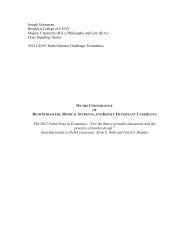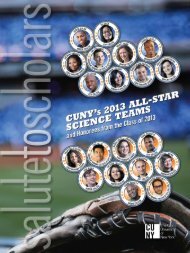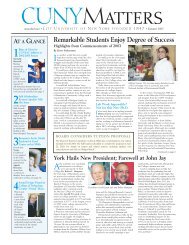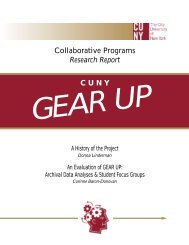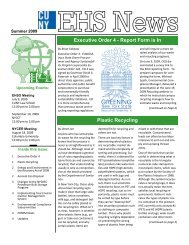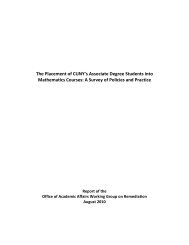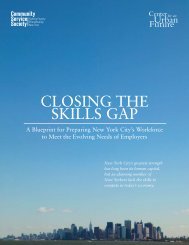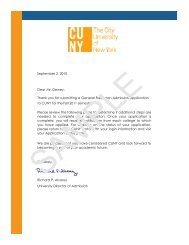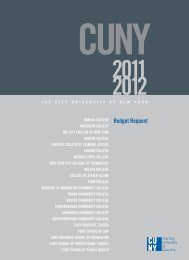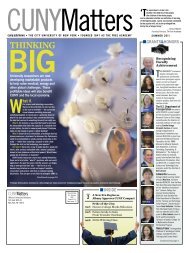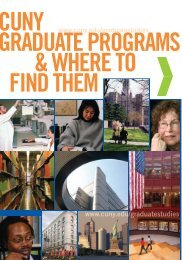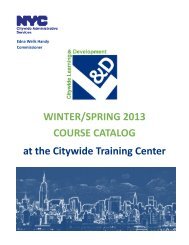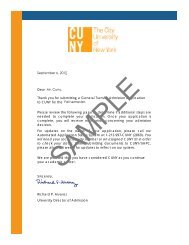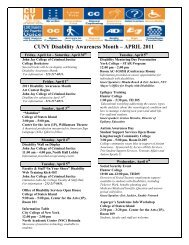CUNY Master Plan 2012-2016
CUNY Master Plan 2012-2016
CUNY Master Plan 2012-2016
Create successful ePaper yourself
Turn your PDF publications into a flip-book with our unique Google optimized e-Paper software.
THE <strong>CUNY</strong> MASTER PLAN <strong>2012</strong>-<strong>2016</strong><br />
Remediation<br />
Average Percentage Increase in Basic Skills Test Scores after Summer Immersion<br />
Fall 2010<br />
23%<br />
17%<br />
12% 12% 13% 14% 15% 13% 14% 20%<br />
18%<br />
15%<br />
18%<br />
18%<br />
20% 20%<br />
Writing Reading Pre-Algebra Algebra<br />
Senior College Comprehensive College Community College University<br />
Percentages are based on admitted first‐time freshmen who did not meet the basic skills requirement on their initial test attempts and subsequently re‐tested<br />
during the summer. Percentages were derived by taking the change in test score (pre‐and post‐immersion) divided by the possible number of points on each test.<br />
The numerator is the average difference between each student’s initial test score and his/her last test score prior to the fall term. The denominator is the maximum<br />
number of points that can be earned on each test (10 possible points on the writing test based on a scale of 2‐12, and 100 possible points on each of the other<br />
tests based on scales of 0‐100).<br />
pilots in contextualized learning in reading, writing, and mathematics; and consider ways to scale up<br />
models of intrusive advisement in a cost-effective manner. <strong>CUNY</strong> will also continue to examine closely<br />
the evidence regarding increases in student learning resulting from the course redesign strategies promoted<br />
by the National Center for Academic Transformation (NCAT), and will continue to consider using<br />
these strategies deemed successful.<br />
Improving the results of remedial instruction is central to raising graduation rates. As Bronx Community<br />
College wrote, “We have been and will continue to explore and support interventions designed to<br />
help developmental students complete their non-credit course sequences more quickly, and to determine<br />
how such interventions can be brought to scale while retaining their effectiveness.” <strong>CUNY</strong>, as a system,<br />
is ideally positioned to chart new directions in developmental education.<br />
English as a Second Language (ESL)<br />
In addition to remedial instruction, <strong>CUNY</strong> is a leader in serving students with English language needs.<br />
Of the roughly 230,000 <strong>CUNY</strong> undergraduates enrolled in fall 2011, 44 percent spoke a native language<br />
other than English. Another 14 percent of <strong>CUNY</strong> undergraduates report that their families speak a language<br />
other than English at home. This means that roughly half of <strong>CUNY</strong> undergraduates speak a language<br />
other than English, with their linguistic diversity encompassing 193 different languages.<br />
<strong>CUNY</strong> will continue to ensure that offering a wide variety of options to English Language Learners is a<br />
priority. Programs include full-time courses, one-on-one tutorials, laboratories, as well as services tailored<br />
specifically for adult learners at all levels. In particular, the <strong>CUNY</strong> Language Immersion Program<br />
(CLIP) provides full-time immersion for first-time freshmen with English language needs who have not<br />
passed their ACT Reading and/or Writing Skills Tests. Upon completion of study in CLIP, students return<br />
to their home campuses for placement into college-level courses.<br />
68



